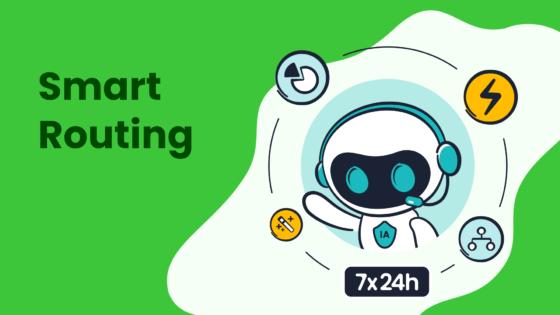Call Center Pricing Explained for Per Call, Per Minute, Per Agent

You pay for call center services using three main call center pricing models: per call, per minute, and per agent. Each pricing model offers a different way to manage costs and measure performance effectively. For instance, per-minute pricing typically ranges from $0.75 to $1.25 per minute, while per-call pricing can cost between $5 and $12 per call. Hybrid pricing models combine a base fee with performance bonuses to optimize value. Sobot provides flexible call center pricing options, allowing you to select the best fit for your business needs. The table below highlights common adoption rates and trends with Sobot and Sobot AI:
| Pricing Model | Typical Pricing Range | Trend Insights |
|---|---|---|
| Per-Minute Pricing | $0.75-$1.25/minute | Still widely used, evolving with Sobot AI. |
| Per-Call Pricing | $5-$12/call | Common for predictable costs. |
| Per-Agent/Hybrid | $2,500+/month (base) + bonuses | Growing with Sobot call center automation. |
Call Center Pricing Models

Per Call Pricing
You pay a fixed rate for each call handled by your call center services. This call center pricing model gives you simple and predictable costs. You know exactly what you spend for every customer interaction, no matter how long the call lasts. Businesses with fluctuating or seasonal call volume, such as retailers during holiday spikes, often choose per call pricing. For example, basic service inquiries usually cost between $2.70 and $5.60 per call, while complex technical support calls can reach $8.00 to $15.00. Industries like financial services and healthcare see higher costs due to compliance and complexity. Metropolitan areas have higher labor costs, which increases the cost of call center services. Outsourcing to offshore locations can reduce expenses by up to 70% (source).
Tip: Analyze at least 12 months of call volume data before choosing per call pricing to spot seasonal peaks.
Per Minute Pricing
Per minute pricing charges you based on the actual duration of each customer interaction. This model offers flexibility and transparency in your call center cost breakdown. You pay only for the time spent on calls, which helps avoid hidden fees. Per-minute rates in the United States range from $0.75 to $1.25, while offshore rates in Asia can be as low as $0.27 to $0.45 per minute (source). If your business has short calls or fluctuating call volume, per minute pricing can help you manage costs. Longer calls, such as those in healthcare or legal services, increase total costs.
| Region | Typical Per Minute Rate |
|------------------|------------------------|
| United States | $0.75 - $1.25 |
| Asia | $0.27 - $0.45 |
| Western Europe | $0.67+ |
Note: Call duration directly impacts your call center cost breakdown in per-minute models.
Per Agent Pricing
The per agent or hourly pricing model charges a flat monthly rate for each agent handling your customer interaction. You get predictable costs and can focus on quality service. This pricing model suits companies with steady call volume and longer customer interactions, such as B2B firms with complex sales cycles. The average monthly cost per agent ranges from $2,600 to $3,400, including salary and service fees. Hourly rates for dedicated agents vary from $8 to $30 per hour.
| Cost Component | Cost Range / Details |
|------------------------------|------------------------------------------|
| Average Monthly Cost per Agent| $2,600 to $3,400 |
| Hourly Rate per Dedicated Agent | $8 to $30 per hour |
| Monthly Flat Rate | Starts at about $100 per month |
Performance-based pricing can combine hourly and per-minute models to balance cost control and agent motivation.
Per-Minute and Pay-Per-Minute Model

How Per-Minute Pricing Works
The per-minute model charges you for the exact time agents spend on customer calls. You only pay for the minutes used, not for idle time or breaks. This pay-per-minute model helps you control your call center cost breakdown, especially if your call volume changes often. Many businesses choose this model for customer service, after-hours support, FAQ handling, and appointment scheduling. You can scale your operations up or down without worrying about fixed hourly costs.
- You pay only for active talk time, not for hold or wrap-up time in many cases.
- Accurate call tracking systems measure every interaction, so billing stays fair and transparent.
- The model encourages agents to handle calls efficiently, but you must balance speed with service quality.
- For example, an online bookstore pays more during a new release but less during quiet periods, matching costs to demand.
Volume Discounts and Tiered Rates
Per-minute pricing often includes volume discounts and tiered rates. As your call volume increases, your per-minute rate can decrease. Providers may offer a 15% discount after a certain number of minutes, and a 25% discount for even higher usage. This structure rewards you for higher usage and helps you manage your call center cost breakdown.
You can choose from different service tiers, such as Basic, Standard, or Premium. Each tier offers more features and support for your interaction needs. You start with basic support and upgrade as your business grows. This flexibility makes per-minute pricing a smart choice for businesses with changing call volume.
Sobot Voice/Call Center Advantages
Sobot’s per-minute pricing gives you flexibility and transparency. You pay only for the minutes your agents spend on customer interaction. Sobot’s AI-powered solutions help you lower costs by:
- Giving agents real-time suggestions, so they spend less time searching for answers.
- Using intelligent IVR to handle simple requests, freeing agents for complex interaction.
- Providing a unified workspace, so agents do not waste time switching between tools.
- Automating repetitive tasks, which saves time and keeps service consistent.
- Routing calls to the right agent, reducing transfers and average handling time.
Sobot supports global coverage with 24/7 availability, so you never miss an interaction. The system guarantees 99.99% uptime, keeping your call center running smoothly. Sobot integrates easily with your existing systems, including CRM and telephony platforms. You get secure, reliable, and scalable service for every customer interaction.
Pros and Cons of Each Model
Per Call Pricing Pros & Cons
Per call pricing gives you a clear cost for every customer interaction. You know exactly what you pay for each call, which helps with budgeting. This model works well if your calls are short or if you have seasonal spikes in volume. For example, a retail business during holiday sales can predict costs easily.
Pros:
- Simple call center pricing structure makes budgeting easy.
- You avoid paying for idle time or long calls.
- Good for businesses with short, frequent calls.
Cons:
- If your calls are long or complex, costs can rise quickly.
- You may pay more during busy periods.
- Not ideal for support teams handling detailed or technical issues.
Note: Businesses often choose per call pricing when they want predictable costs and have a steady call pattern.
Per Minute Pricing Pros & Cons
Per minute pricing charges you only for the time agents spend on calls. This model fits companies with changing call volumes or short calls. You get a detailed call center cost breakdown and only pay for what you use. Many cloud-based call centers use this model to offer flexibility.
Pros:
- You pay only for active talk time, not for breaks or idle time.
- Volume discounts lower your per-minute rate as usage grows.
- This model aligns costs with actual demand, making it flexible.
Cons:
- Long calls can increase your total costs.
- Tracking per-minute usage requires accurate systems.
- Service quality may drop if agents rush to keep calls short.
| Factor | Benefit | Drawback |
|---|---|---|
| Flexibility | High, scales with demand | Costs rise with long calls |
| Transparency | Clear call center cost breakdown | Needs accurate tracking |
Tip: Use per minute pricing if your business has fluctuating call volume or you want to match costs to actual usage.
Per Agent Pricing Pros & Cons
The per agent or hourly pricing model charges a flat rate for each agent, often monthly or hourly. This model gives you predictable costs and works well for steady call volumes or longer calls. Many businesses use the hourly pricing model for dedicated support teams.
Pros:
- Predictable costs help with long-term planning.
- You can focus on service quality, not call length.
- Works well for complex or high-value customer interactions.
Cons:
- You pay for agent time, even during slow periods.
- Less flexible if your call volume changes often.
- May be inefficient for businesses with seasonal demand.
Many businesses weigh the trade-offs between cost, flexibility, and service quality by considering agent salaries, technology, and seasonal staffing. Cloud-based solutions like Sobot help you scale up or down, reducing upfront costs and improving efficiency with AI-driven automation.
Choosing the Right Call Center Pricing
Key Factors (Volume, Duration, Expertise)
When you select a call center pricing model, you need to consider several important factors. These factors shape your cost management strategy and help you get the most value from call center outsourcing. The table below shows how each factor influences your choice:
| Factor | Influence on Pricing Model Choice | Explanation |
|---|---|---|
| Call Volume | Affects economies of scale | Higher call volume lowers per-call costs and supports flexible pricing |
| Average Call Duration | Impacts labor and operational costs | Longer calls require more agent time, increasing the cost of call center services |
| Agent Expertise | Determines service complexity and training needs | Skilled agents handle complex issues, raising labor expenses and benefits |
| Geographic Location | Influences labor costs and market rates | Lower labor costs in some regions make outsourcing more affordable |
| Technology Integration | Affects efficiency and pricing | Advanced tech like AI and CRM improves operational efficiency but may add costs |
| Service Levels | Complexity of services provided | Basic services cost less; specialized support needs more resources |
| Call Center Model | Type of operation (inbound, outbound, blended, specialized) | Different models have unique cost structures and agent skill requirements |
You should also track metrics like call arrival rate, average handle time, and agent utilization rate. These help you understand your call volume trends and agent performance. If your business has high call volume and long calls, you may need a model that supports scalability and advanced expertise. If you handle simple inquiries with short calls, a flexible per-minute or per-call model may work best.
Tip: Review your average call duration and agent expertise needs before choosing a pricing model. This helps you avoid unexpected labor expenses and benefits.
Decision Criteria for Businesses
You need to match your business goals with the right call center outsourcing model. Start by defining your mission and objectives. If you want predictable costs, a fixed fee or per agent model may suit you. If your call volume changes with the season, a per-call or per-minute model gives you flexibility.
Consider these decision criteria:
- Technology platform costs: Choose a solution that fits your budget and feature needs.
- Telecommunications expenses: Cloud-based platforms like Sobot reduce hardware costs and simplify integration.
- Labor costs: Calculate agent salaries, location, and scheduling efficiency. These are the largest part of the cost of call center services.
- Consulting and integration fees: Plan for one-time costs to connect your systems and get expert advice.
- Automation and omnichannel solutions: Use AI chatbots and unified workspaces to lower cost-per-call and improve customer satisfaction.
- Vendor selection: Focus on your business needs, not just vendor features.
- Strategic budgeting: Set clear goals to align spending with desired outcomes.
If your business is a startup or growing company, you may prefer a SaaS model with flexible pricing and low upfront costs. Larger enterprises often choose fixed or tiered pricing for predictable budgeting. Industry-specific needs, such as compliance or CRM integration, also affect your final choice.
Note: Monitor your call volume trends and adjust your pricing model as your business grows. This helps you maintain cost management and operational efficiency.
Sobot Customer Story: Opay
Opay, a leading financial service platform, faced challenges with high call volume and complex customer inquiries. The company needed a solution that could handle seasonal spikes and improve customer satisfaction. Opay chose Sobot’s omnichannel call center outsourcing solution.
After switching to Sobot, Opay saw impressive results:
- Customer satisfaction increased from 60% to 90%.
- Operational costs dropped by 20%.
- Service efficiency improved as Sobot’s AI chatbot automated basic inquiries.
- Human agents focused on complex issues, boosting productivity.
- The platform scaled easily to handle large volumes without performance loss.
Sobot’s unified workspace and intelligent IVR helped Opay manage interactions across voice, email, and social media. The solution allowed Opay to match its needs with the right pricing model, balancing cost and service quality. Opay’s experience shows how Sobot’s technology supports cost management and operational efficiency, even during seasonal demand changes.
Success Story: Opay used Sobot’s omnichannel solution to reduce costs and improve customer satisfaction. You can achieve similar results by choosing a pricing model that fits your call volume, service complexity, and business goals.
How to Match Your Needs with Sobot’s Offerings:
- If you have unpredictable call volume, choose per-minute or per-call pricing for flexibility.
- If you need steady support and longer interactions, consider per agent or fixed fee models.
- Use Sobot’s AI-powered features to automate routine tasks and free agents for high-value work.
- Take advantage of Sobot’s global coverage and integration options to support growth and scalability.
Sobot helps you optimize the cost of call center services while maintaining high satisfaction. You get a solution that adapts to your business size, industry, and operational needs.
Sobot Solutions for Call Center Pricing

Voice/Call Center Features
You get advanced features with Sobot’s voice and call center services. These features help you deliver better customer interaction and improve your call center outsourcing results. Sobot uses AI-driven technology to automate repetitive tasks and provide 24/7 support. You can handle complex, multi-turn conversations with near-human quality. The system recognizes speech in real time and supports multiple languages. Sobot’s intelligent routing sends each interaction to the right agent, reducing wait times and boosting satisfaction.
- Multimodal voice AI combines speech recognition and natural language processing.
- Warm transfers and knowledge-base grounding create smooth customer experiences.
- Post-call analytics show sentiment and success rates, helping you track performance.
- Sobot integrates with your CRM, ticketing, and IVR systems for seamless workflows.
- Enterprise-grade security and compliance keep your data safe.
You can deploy Sobot quickly with no-code tools and scale as your business grows. The branded call ID and spam prevention features protect your reputation. Sobot’s technology helps you resolve issues 25% faster and increase customer satisfaction by 35%.
Omnichannel Benefits
Sobot’s omnichannel solution lets you manage every customer interaction across voice, chat, email, and social media. You can switch between channels without losing context. AI-powered tools automate up to 95% of customer interactions, saving you time and increasing operational efficiency. Predictive analytics and real-time personalization engines help you understand customer needs and deliver tailored experiences.
- Unified customer profiles give you a complete view of each interaction.
- NLP and conversational AI keep communication consistent across channels.
- AI chatbots handle routine questions, freeing agents for complex tasks.
- Businesses report productivity increases of up to 400% and save billions of hours each year.
You can use Sobot to anticipate customer needs, improve engagement, and build loyalty. Most shoppers say AI improves their experience, showing the value of Sobot’s omnichannel approach.
Why Choose Sobot
| Reason Category | Supporting Evidence |
|---|---|
| Pricing and Scalability | Flexible pricing starts at $30/month for SMBs. Custom enterprise plans and usage-based models help you manage seasonal demand. Sobot reports a 95% satisfaction rate and 2.5× increase in inquiry handling during peaks. |
| AI-driven Sentiment Analysis | Sobot’s AI interprets customer emotions and tone, handling up to 70% of routine queries. Human agents focus on complex interaction, improving personalized service. |
| Multilingual Support | Sobot supports multiple languages and cultural nuances, helping global brands connect with customers worldwide. |
| Real-time Insights | Live dashboards let you respond quickly to customer emotions. You can increase revenue by up to 15%. Most customers value responses within 10 minutes. |
| Case Studies | Brands like OPPO and Agilent report high resolution rates and efficiency boosts using Sobot’s call center services. |
| Integration and Technology | Sobot’s omnichannel integration and emotion interpretation improve customer experience and operational efficiency. |
| Transparency and Growth | Transparent pricing and scalable solutions support your long-term growth and cost control. |
Tip: Sobot’s flexible call center outsourcing options and advanced technology help you optimize every customer interaction and control costs as your business grows.
Choosing the right call center pricing model depends on your business needs. Per call and per minute models work well for fluctuating demand, while per agent pricing suits steady, complex support. Sobot’s AI-powered platform automates routine tasks, reduces costs, and boosts customer satisfaction by speeding up response times. You gain omnichannel support and analytics to improve every interaction.
- Sobot can cut service costs by up to 50%
- Productivity increases by about 70%
- Faster handling times lead to higher satisfaction
Evaluate your requirements and see how Sobot can help you deliver better customer satisfaction and operational efficiency.
FAQ
What is the difference between per call, per minute, and per agent pricing?
You pay per call for each customer interaction, per minute for the time spent on calls, and per agent for each agent’s work time. Each call center pricing model fits different business needs and budgets.
How does Sobot help reduce call center costs?
Sobot uses AI-powered features like intelligent IVR, automated workflows, and unified workspaces. These tools help you lower average handle time and reduce labor costs, making your call center pricing more efficient.
Can I switch between pricing models as my business grows?
Yes, you can change your call center pricing model with Sobot. You may start with per minute pricing and move to per agent or hybrid models as your call volume and needs change.
Does Sobot support global call center operations?
Sobot provides global coverage with 99.99% uptime. You can access phone numbers worldwide and support customers in multiple languages, making it easy to manage international call center pricing.
What features does Sobot offer for call center management?
You get intelligent IVR, AI-powered voicebots, real-time analytics, and seamless CRM integration. Sobot’s features help you improve customer satisfaction and control your call center pricing.
See Also
A Comprehensive Guide To The IT Call Center Agent
Exploring The Efficient Functioning Of Call Center Automation
Breaking Down The Expenses Of Live Chat Outsourcing
